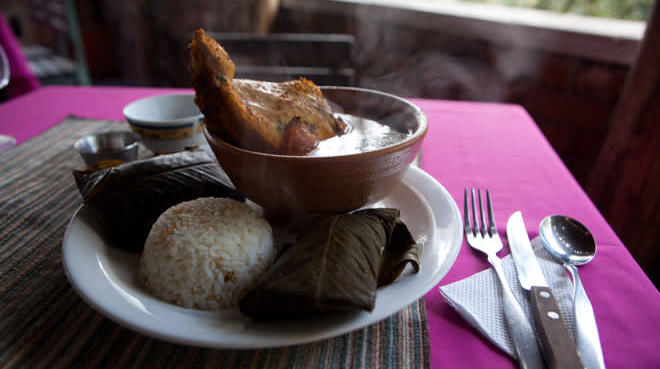Guatemala's Cuisine Reflects Its Hearty Maya Heritage
When I traveled to Guatemala, I was focused on its legendary scenic beauty. I wanted to see the volcanoes, mountains, lakes, and pastel-colored colonial architecture dotting most of the towns. Touching down in the highlands of Western Guatemala, it was indeed striking: deep emerald ravines surrounded glistening lakes and sacred Mayan ruins seemed to cover every other plaza. Guatemalan culture is complex, encompassing 21 different Maya Indigenous groups. This has led to a range of influences on everything from traditional dress to spirituality, and certainly on the food as well. In fact, there was one special dish that showcased the Mayan influence so beautifully that it almost made me forget about the landscapes that first attracted me to the country.
Visiting the small mountain towns in the region, I spotted tortillas, empanadas, and tamales in street carts and stands. Based on these familiar staples, it would be easy to assume that Guatemalan cuisine is just like that of its neighbor Mexico, but I quickly realized that isn't the case. Although it has some crossover with other Latin American countries, Guatemala has a range of distinctive dishes that you won't find anywhere else, mainly because of the mix of Maya traditions. Many have been prepared the same way for 2,000 years.
One of the first traditional dishes that I sampled was the spicy pepián. I was in the bustling town of Tecpán, where women walked the narrow streets in intricate hand-loomed huipils, the colorful tunics that communicate the wearer's Maya group via style, color, and symbols. Surrounded by forests and mountains, Tecpán was the first capital of Guatemala and is noted today as its gastronomy capital, with over 50 restaurants scattered along the edge of the Inter-American Highway. I stopped at the town's most famous roadside cafe, Katok, which was designed in open-air style with a thatched roof. The long list of traditional dishes was slightly intimidating but my guide, Jose', helped me decipher the dozens of soups, stews, and grilled items on the menu. I went with pepián, which Jose' pointed to as the most classic selection; the stew arrived in a deep clay dish accompanied by rice, fresh corn tortillas, and chili peppers. The aromas of roasted spices floated up from the bowl, and when I tasted the thick concoction, the nutty flavor of pepitas, or pumpkin seeds, stood out. The savory mixture also featured sesame seeds, chicken, carrots, tomatoes, and güisquiles, a light green squash with a bland taste. The stew was only slightly spicy on its own, but once I added the chilis, the richness of the entire dish intensified, with a hint of bitterness from the roasted peppers. Jose' explained that the vegetables had been roasted in a comal, a clay griddle over an open fire that's the hallmark of Maya cuisine.
I enjoyed the flavorful pepián, but it wasn't until I tried kaq-ik that I became hopelessly enamored with Guatemalan food. It was in the charming lakeside village of San Pedro la Laguna. Positioned between the crystalline Lake Atitlán and San Pedro volcano and filled with weavers displaying vibrant textiles, the town so captured me visually that I didn't even think about eating until late in the evening. I went to a corner comedor, a small set-menu diner near my hotel.
The first thing listed was kaq-ik, and since the waitress explained that it's Guatemala's unofficial national dish after pepián, I felt compelled to order it. A heaping bowl was placed before me with rice, tortillas, and tamales steamed in banana leaves. The deep red color of the soup indicated the spice level, and when I took a sip the slow burn of multiple spices tickled my tongue. I scooped up more spoonfuls and the turkey, cilantro, achiote, coriander, and the local Cobanero chili all sang together on my tongue. A fat turkey leg was served on the side and I was instructed to dip the meat into the soup along with the tamale and rice. It was a party in my mouth and I didn't want it to end.
The waitress flashed a dimpled smile when she saw my enjoyment and explained that kaq-ik is connected to the Q'eqchi' Maya group. The red color carries meaning in addition to heat: it represents the blood spilled in rituals by their ancestors. Q'eqchi' women still slaughter, clean, and cook the turkey in accordance with tradition, and the dish is a required part of wedding banquets. The complexity of the spices was so unforgettable that I continued ordering the dish in every town that I visited in Guatemala. I managed to eat other excellent national staples, too (like joco'n, a tangy, vibrant green stew of chicken and tomatillos), but none of the country's soups and stews haunted me quite like kaq-ik. It leaves a lasting impression, just as it's done for centuries.
